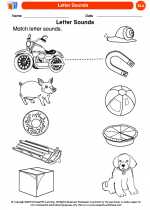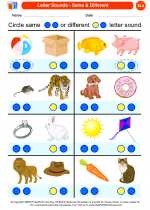Letter Sounds - Same & Different
Teaching kindergarten students about letter sounds is an essential part of their early literacy development. Understanding the concept of same and different letter sounds helps them recognize and differentiate between various letters, which is crucial for their reading and writing skills. Here's a study guide to help your students grasp the concept of letter sounds - same and different.
Introduction to Letter Sounds
Start by introducing the students to the concept of letter sounds. Explain that each letter makes a specific sound and that some letters can make the same sound, while others make different sounds.
Same Letter Sounds
Provide examples of letters that make the same sound, such as 'b' and 'd' which both make the /b/ sound. Encourage the students to listen to the sounds and identify the letters that make the same sound.
Different Letter Sounds
Next, introduce letters that make different sounds, such as 'm' and 's'. Explain the distinct sounds each letter makes and ask the students to listen carefully to identify the differences in the sounds.
Activities to Reinforce Learning
- Matching Game: Create a matching game where students pair letters that make the same sound.
- Sound Sort: Provide pictures of objects and ask students to sort them based on the initial letter sounds, identifying whether the sounds are the same or different.
- Letter Sound Hunt: Have a letter sound scavenger hunt where students find objects in the classroom that start with the same or different letter sounds.
Assessment
Conduct a simple assessment to gauge students' understanding of same and different letter sounds. Ask them to identify and articulate the sounds of various letters, both individually and in pairs, to see if they can distinguish between same and different sounds.
By providing a variety of engaging activities and opportunities for practice, students can develop a strong understanding of letter sounds and the concept of same and different sounds.
[Letter Sounds - Same & Different] Related Worksheets and Study Guides:
.◂English Language Arts Worksheets and Study Guides Kindergarten. Letter Sounds - Same & Different

 Coloring Worksheet
Coloring Worksheet
 Worksheet/Answer key
Worksheet/Answer key
